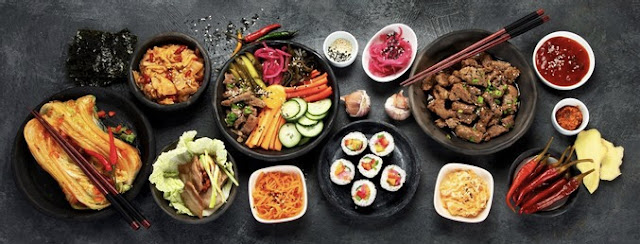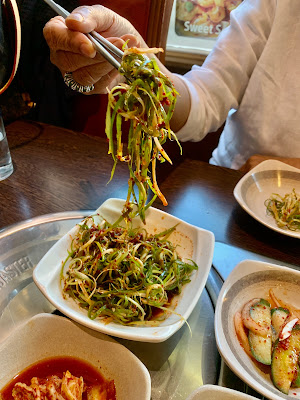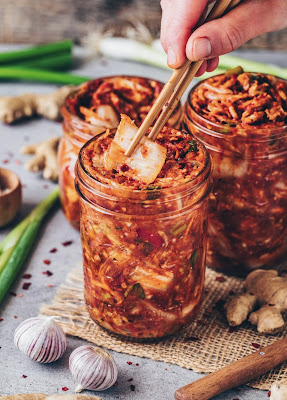Let Korean Cuisine Surprise You! Korean Cuisine for Everyone! Blog 42
25th July 2023
Blog 42
Let Korean Cuisine Surprise You! Korean Cuisine for Everyone!😊
nguptatravelscrapbook.blogspot.com
Korean food has rich, spicy, sweet, sour, salty, and bitter qualities, gaining a grip on diners. Besides flavour, Korean cuisine is also one of the freshest, healthiest, containing ingredients that are good for the human body.
Today I am here to celebrate the goodness and virtuousness of Korean cuisine with you. If you're not hungry now, you will be by the end of this blog!😋
In the UK, the presence of South Koreans began increasing in the 1970s, with our local neighbourhood, New Malden, now the most densely populated place for South Korean residents in Europe (20k+ and counting). New Malden is about 15 miles down south from Central London. I encountered Korean individuals living in Wimbledon, UK, as early as 1985. As a result, a few school-run mums became my friends, and from there, I started my Korean food journey, watching and learning from them. Over the years New Malden neighbourhood and it's shopping High Street have developed numerous Korean food joints, fashion item shops, banks, travel agencies, K-mega supermarkets, and K -plazas, all serving this immense South Korean population.
Spiced Green onions served as banchan
My Korean interest was furthered and expanded as our daughter-in-law hailing from Seoul, the capital city of South Korea, has familiarised us with their incredible vibrating and thumping culture, including food customs, K-pop,s and K-dramas, to name a few. Over time, I have dined in selected local Korean eateries and a few high-end Korean restaurants in London. I have engaged many of my Indian friends in these Korean restaurants for an introduction to Korean delicacies, which they have thoroughly enjoyed.
Korean food is now a must-include food scene in London and around, and many of their delicacies, like Kimchi, mandus (Goyzas), red chilli paste, and ready-made pot-noodles occupy prominent shelf space in major supermarkets, food stores and delicatessens.
Today after enjoying a genuine Korean spread-out delicacy in a New Malden restaurant, I considered summarising my Korean food experiences through my travel blog, where I usually write about the local food habits I have encountered.
Today's food
In the last few years, there has been a tremendous influx of Korean food in London. New Korean operators occupy restaurants all over the city. The established restaurants are competing with new Korean ideas and food trends. According to the most recent estimate, currently, there are approximately 150 new Korean restaurants in London.
The reason for the success of Korean food in London may be that the food is exotic yet familiar in taste and spicey too, not at all bland. Up to five years ago, diners' most popular cuisine choices were Thai or Chinese food. The current expectation is that Korean food will become increasingly influential and dominant as awareness of Korean culture within the United Kingdom grows. And thanks to the ever-increasing popularity of K-pop (e.g., BTS) and K- dramas.
Koreans in London
The New Malden area (as mentioned above) is often referred to as the Little Seoul, but there are other areas in London where Korean restaurants have sprung up. Some of these most popular areas for Korean restaurant trends are Soho, Covent Garden, Kensington, and Notting Hill Gate, offering a Korean restaurant chain called Bibimbap.
The East End of London is another popular area for Korean restaurants. Broadway Market offers various Korean cuisine cooking classes charging up to £500 for a three-hour Korean workstation and cooking class.
Korean food has a rich, illustrious history – from ancient semi-nomadic traditions, flourishing in royal houses and temples, transforming over centuries of social and political change, and finally culminating in the many varied, flavour-imbued dishes served in Korean restaurants today.
And as we all know, eating history is the best way to enjoy it.
I have outlined some predictable entries on any Korean menu, with nearly at least two of these dishes on every table. Every dish has an English name and corresponding picture on the menu. Korean cuisine is primarily based on rice, vegetables, tofu, seafood and meats(mainly Beef). Overall, dairy is absent from the traditional Korean diet. Commonly used seasonings and flavourings in Korean cooking include sesame oil, fermented bean paste(called Doenjang), soy sauce, salt, garlic, ginger, gonchugaru( red pepper flakes), gochujang( fermented red chilli paste), and Napa cabbage.
Mandus (Goyza in Japanese cuisine)
While dumplings can be made with any fillings, with or without meat, the typical gyoza is made with ground pork and cabbage. In contrast, the mandu initially was not made with any meat since Buddhism prohibited meat consumption when it was allegedly first introduced. Nowadays, one can enjoy Mandus with any fillings of their choice.
Fermented deep red spiced kimchi
Kimchi is a substantial part and the ultimate soul-enriching of Korean cuisine. Nearly every meal includes a side dish of Kimchi. A collection of kimchis is called Banchan, usually served as all-inclusive assortments. Kimchi is prepared using fermented and salted Napa cabbage before being seasoned with ground red chillies, ginger and garlic.
Other forms of kimchi, We love it!
In addition to being very flavourful, fermented and spicy, Kimchi containing natural probiotics is beneficial for health by being antibacterial and anti-carcinogenic. Kimchi has become almost as famous in London as in South Korea. In our area, a vendor provides a door-to-door, regulated supply of Kimchi, whereby we always have our supply of Kimchi in our pantry.
Bibimbap:
The rice-based dish was named after the Korean word for rice, bap. The dish includes assorted vegetables and is highly versatile. Bibimbap can be served with a wide variety of different ingredients. The traditional version of the dish is prepared using thinly sliced meat, raw egg yolk and seasoned and sauteed vegetables. The vegetables most often used include courgette, mushrooms, spinach, cucumber, cabbage, radish and soybeans. The dish is healthy with a beautiful appearance served in a hot stone bowl which can be a heartening single bowl of nourishing food.
Bulgogi (Korean BBQ):
Table top BBQ
Bulgogi (Korean BBQ): One of the most popular Korean dishes is thinly sliced Beef, chicken or pork marinated in a wide variety of Korean spices and sauces, including chilli, garlic, sesame oil and soy sauce. The dish is served raw. Each diner decides how long they want to cook their meat using a grill placed on the table or a built-in grill. Various condiments for your grilled meats – dressed spring onions, garlic, salt dredged in sesame oil, fermented soybeans (doenjang) and, of course, some fresh lettuce for wrapping everything up the meat or tofu. The dish is popular due to the explosive flavours and sensational experience; extremely delicious, incredibly satisfying and hands-on. One must be mindful that Korean food is exceptionally spicy; the dishes are almost red, with red chillies used as a paste or a powder. Bulgogi is a trendy Korean dish, always enhanced sharing with friends and family!
Tteokbokki:
Tteokbokki is one of the most popular Korean Street food snacks. Preparing the dish is a well-known linguistic nightmare. The dish uses numerous lengthy, cylindrical rice cakes instead of rice grains. The snack rests in a sweet chilli sauce. There are stalls selling nothing but this dish. In most cases, extras are included, such as seafood, noodles, fish cakes and ribs.
Korean Fried Chicken (Yangnyeom Chicken)
Chicken is doubly deep-fried and coated with sticky, spicy, sweet sauce. The taste is almost magical, super delicious and addictive too! One can watch people enjoying a feast of this super delicious Korean chicken in almost any K-drama.
Fried Tofu
Thick tofu is marinated in spicey, followed by frying or grilling on the table. Heavenly, accompanied by all the banchan!
Pajeon (savoury pancake):
Kimchi pancake
Pajeon is a pancake-like food originating in South Korea. The main ingredient of the snack food is green onions or Kimchi. The batter is prepared with flour, wheat and eggs before being poured into a hot pan over green onions. There are a lot of different versions of this popular Korean dish.
The New Malden High Street has multiple Korean food joints like Yami, Haru, K-J cuisine, Palace, Jin-Go-Gea, Sorabol, Imone, K-Town, Kangnam, Yokiyo, Tree Stone BBQ and You Me etc. In New Malden, most Korean restaurants are humble, homely and priced without the London premium. They offer rustic home-style cooking done by your Korean mama in the kitchen. The decor isn't anything to shout home about with its drop ceiling tiles, bare wooden tables & chairs, and patinaed walls needing a lick of paint – but who cares if the food is good?
Korean food in preparation at home
Apart from these eateries, many cafe houses serve coffee, homemade sweet cakes, etc. and are always crowded with younger Koreans exchanging the local and the far away home gossip. They update each other with the latest K-pop and K- dramas. I must admit that I have watched many of these dramas in the last three to four years. A few are Mr Sunshine, Crash Landing on You, Our Blues, Itaewon Class, Hometown Cha-Cha-Cha, Vinchenzo, Extraordinary Attorney Woo, When the Camellia Blooms, Business Proposal, Squid Game, The King's Affection etc etc.
Are you a foodie looking to explore new tastes and flavours? Look no further than Korean cuisine. With its bold, spicy flavours and unique ingredients, Korean food has taken London and its surroundings by storm in recent years.
Korean cuisine is known for its emphasis on fresh ingredients, bold flavours, and unique spice blends. There's something for every taste bud, from traditional fermented dishes like Kimchi, delicious tofu to sizzling Korean BBQ. Its complex and rich flavours make it a true feast for the senses.
I have added some photos here to add a dimension to this food blog. Please feel free to send your comments Via Google, FB, Instagram. Thank you for browsing my blogs.















Comments
Post a Comment